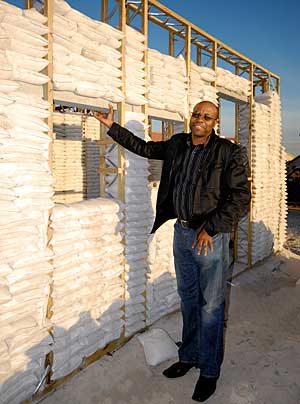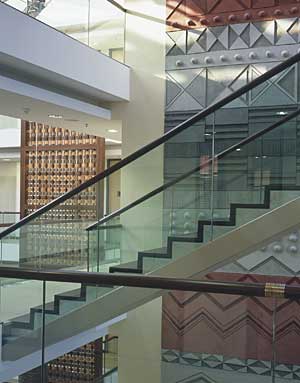Following two decades of prison and exile, Luyanda Mpahlwa is now a founding partner in the award-winning South African firm MMA Architects.
He spent two decades in prison and in exile, but Luyanda Mpahlwa is now a partner in a thriving architectural practice. MMA Architects—his Cape Town, South Africa, firm—has gained international recognition for projects both at home and abroad. The firm’s work on an innovative housing project in the impoverished Mitchell’s Plain Township has just been honored with the Curry Stone Design Prize, a $100,000 humanitarian award established this year to pay tribute to designers tackling the needs of the world’s poor.


Luyanda Mpahlwa with his firm’s housing project in Mitchell’s Plain Township, which won the inaugural Curry Stone Design Prize (top). MMA Architects’ South African embassy in Berlin (above).
Mpahlwa has also been busy serving as a technical advisor for stadium construction as his native country gets ready to host the 2010 FIFA World Cup soccer tournament—the first on African soil. It’s an exciting moment for him and his homeland, but it has taken a long time for both to get here.
In 1980, his anti-apartheid activities landed Mpahlwa on Robben Island, the brutal penal complex off the coast of Cape Town where Nelson Mandela famously passed many long years. Following his release in 1986, Mpahlwa gained refuge in Germany through the aid of Amnesty International when it was determined to be unsafe for him to remain in South Africa. He resumed his architectural studies—which had been interrupted by the political turmoil and his incarceration—in Berlin, a place that would soon face its own upheavals in the wake of the Berlin Wall’s demise in 1989.
“I was in Berlin during a time when Germany was undergoing a transformation,” recalls Mpahlwa, who stayed on in the new capital after receiving his architectural diploma. “As a recent graduate, you didn’t need to do anything and you had four or five job offers. There was so much happening, you could even choose the kinds of projects you wanted to work on.” He would eventually work on a campus of embassy buildings for the Nordic countries—experience that would prove very useful.
After returning to South Africa and setting up his own office in Cape Town in 2000, he got wind of his government’s plans to build an embassy in Berlin. “I teamed up with two other South African architects who had been in exile with me in Germany and said, ‘Guys, we’ve got to get this.’” And they did—making it the first major commission by the new South African government in a foreign country to be awarded to a Black-owned architectural firm.
But designing a building to represent a newly democratized nation whose only architectural legacy was the result of outside cultures was no easy task. “There are strong European and American influences,” Mpahlwa explains, “and yet there are very deep cultural experiences of how the indigenous people have articulated their spaces.”
The resulting 50,000-square-foot building, completed in 2003, expresses the diversity of South Africa by incorporating local materials like sandstone from the Mpumalanga region, and traditional crafts such as rock art, carved wood, forged metal and basket weaving. An old building technique of carving mud to create murals was reinterpreted in a modern way.
“This art has been passed down over generations by women,” says Mpahlwa. “We found some who are earning a living from carrying on the tradition and brought them to Berlin. Their presence on the building site created quite a phenomenon—no one in Berlin had seen women on scaffolds before.”
Since, as Mpahlwa puts it, “you don’t build embassies every day,” the firm—which has grown to twenty employees—created a niche for itself in the public sector. Most of its subsequent projects are located in former township areas, where it is building, upgrading and reconstructing schools, hospitals, and community centers.
Its award-winning housing project, initiated by the South African organization, Design Indaba, to pioneer new affordable housing solutions, features exterior walls composed of sandbags. [Link to October CEU]. Another housing project the firm is currently designing, for a 500-unit sustainable development, incorporates solar heating and on-site wastewater treatment.
“It was always my intention to return to South Africa and contribute to the building and development of my country” says Mpahlwa, who considers himself to be one of the “fortunate ones.”




